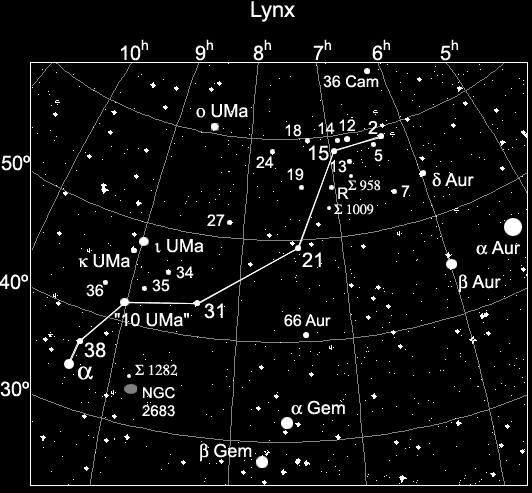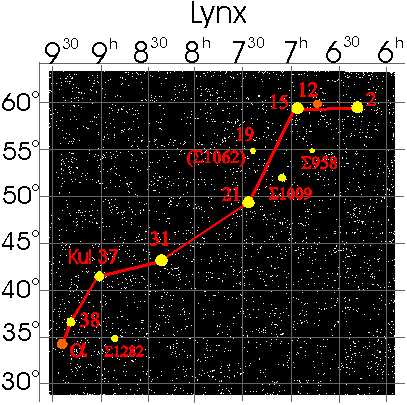
Lynx is a faint and obscure constellation found between Gemini and Ursa Major. The constellation is nearly circumpolar. In summer while it's right-side up, it's very close to the horizon, dipping below the horizon in the northern US and southern Canada for most of the night. For that reason we'll visit it in the winter, when it is high in the sky. However it'll be upside down if you view it facing north. The best way to study Lynx in the winter is to face south and then lay flat on your back and stare straight above you. Lynx will be right-side up nearly at the zenith point. First, with the naked eye locate Castor and Pollux, the Gemini twins. Now find the Big Dipper of Ursa Major -- as you still face south. Lynx lies at a NW-SE slant between these two.
The brightest star and only Greek-labelled star is alpha Lyncis with a visual magnitude of 3.1. The rest of the stars are 5th- and 6th-magnitude. So you should choose a particularly dark night to explore Lynx. Lynx has many splendid binaries, which are best explored with a telescope. Even a small telescope will show some very fine binary systems. If you've no telescope, even with binoculars you can learn to find your way about, to get acquainted with this practically unheralded northern constellation. It is recommended that you study Cancer first.

Alpha Lyncis is a red giant 222 light years away, with a visual magnitude of 3.14. Finding alpha Lyncis can be a challenge, particularly if you don't enjoy the most perfectly black skies. The surest way to locate alpha Lyncis is to start in Cancer. Locate iota1 Cancri. From here move up to the sigma-2 sigma-3 stars just to the northeast. Now place sigma-2 and sigma-3 at the right edge of your glasses. You should see alpha Lyncis on the left. Centering your glasses on alpha, you'll see some fainter stars from Leo Minor to the east.
The vicinity of alpha Lyn has some fine binaries which, if you can't resolve, you can at least find in binoculars. One of these in the same FOV as alpha, but to the west is Struve 1282. Struve 1282 is a splendid binary of 7.7 and 7.8 stars, 3.7" separation at 278º. To the northwest of alpha is the bright 38 Lyncis, a fine binary suitable for medium sized telescopes: 4.0, 6.3; 228º, 2.9". The binary designation of this star is Struve 1334. To the north-northeast of 38 Lyn is an even finer sight: Struve 1338, two nearly equal stars (6.9, 7.1), a challenge for medium telescopes as it is a rapidly orbiting binary with a period of 220 years. Another rapid binary in this region is Kui 37 (4.2, 6.5), also known as 10 UMa, as it once was part of that constellation. This star's orbit is even faster, at 21.85 years. the 2000.00 values are: 46º at 0.6". This selection of binaries is only a few of the many found in the northern extremes of this constellation.
